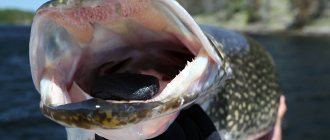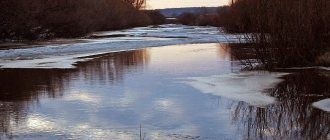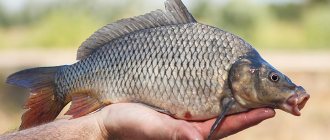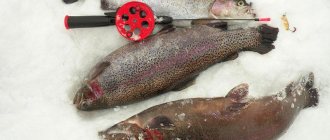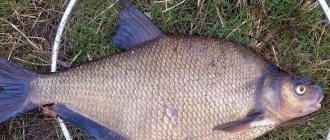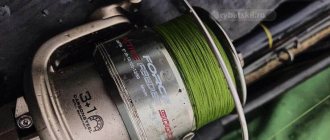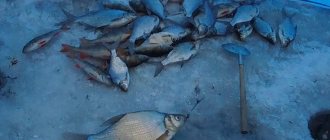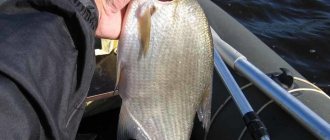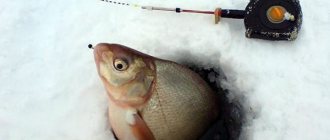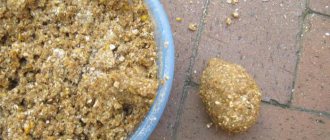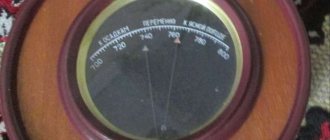Biting calendar
| January | February | March | April | May | June |
| — | — | — | + | +++ | + |
| July | August | September | October | November | December |
| +++ | +++ | +++ | + | — | — |
There are several periods of active bream biting throughout the year.
Seasonal Fishing Guides
| In the spring, fish bite well before spawning. It is during this period that trophy specimens are caught. |
| The best time in summer begins with the flowering of winter rye. |
| A good bite continues until mid-autumn, when bream gathers in schools and rushes to their wintering grounds. The colder it is, the deeper the bream descends. |
| In winter, good fishing occurs on first ice, as well as at the end of winter or beginning of spring, when the melt waters go under the ice. |
Lures
If in winter and early spring before spawning, bream, like many other carp fish, eats mainly animal food, then after spawning, it is not averse to snacking on plant food. Taking into account what the bream eats at certain times of the year, you need to offer it bait or bait.
Baits:
- bloodworm;
- maggot;
- earthworm and dungworm;
- caddisfly;
- mormysh.
Nozzles:
- peas;
- corn;
- pearl barley;
- pasta;
- bread;
- dough.
In addition to everything listed that bream bites on, it very willingly eats sandwiches offered to it from the various components listed above. For example, this combination works well: pasta – maggot – corn.
Finishing the conversation about baits, it should be noted that bream prefer large-sized baits, according to the principle “a big piece and the mouth rejoices.” Therefore, we give advice: it is better to put large baits and baits on the hook. If it is a worm or maggot, then a bunch. If you use corn, then a few grains, if you use dough, then a good piece.
Bream habitats
In reservoirs and lakes, bream often change their sites. Flocks move throughout the water area of the reservoir, stopping only in areas with rich aquatic vegetation. Despite the fact that fish love deep places in lakes, bream goes to the edge of the algae to feed.
River bream prefers holes, quiet reaches, pools with a clay bottom, and ledges going into the depths like terraces. Often the fish concentrate far from the channel in bays and creeks with considerable depth. Usually there are thickets of algae nearby where the bottom is muddy.
Bream spawning
The fish reaches sexual maturity at the age of 5-8 years. By this time, the body length is 30 cm. The mating season for bream occurs within a month, when the water temperature reaches 12-15 degrees. The depth of the spawning ground is 0.2-2.5 m. But even in one river or reservoir, some individuals begin to spawn at the moment the willow leaves bloom, while others spawn only at the end of the flowering of the gardens. Bream lay their eggs in places flooded with spring water directly on the vegetation. If the mating season in a reservoir goes smoothly for 10-14 days, then after two weeks you can start fishing for bream.
During spawning, it is useless to hunt this valuable fish. For about two weeks, the bream stops feeding. But it is also important to remember that fish love peace. Will not take bait in noise. It is not for nothing that in ancient times in some settlements where bream were caught, it was forbidden to ring church bells. The noise scared the fish and could deprive an entire village of food.
Finding a fishing spot
When looking for a place to catch bream, you should remember that the fish does not like to feed at depth in spring and summer.
It approaches the coastal zone, especially when there is a strong wind and there is a breaking wave. Hitting the steep shore, the wave washes away the soil and attracts a flock. River bream should be looked for in a quiet current with a depth of at least 2.5 m. The fish is found on the reverse current, near holes, on wide reaches, near creeks. The ideal period for fishing is considered to be 2 weeks before spawning and the same amount after the end of the mating season. The spring bite is considered the most productive. If you are fishing for bream from a boat, then using an echo sounder is a must. Look for depths of 10-12 to 15 meters. For fishing from the shore, you can use the jig method of tapping the bottom or a marker float.
In winter, bream occupies the deepest sections of rivers and reservoirs. Therefore, ice fishing is usually carried out at a depth of at least 6 m. Depth differences and channel edges are especially catchy. But in the winter months the fish are still inactive. If you plan to go fishing, do it during the thaw.
Bream fishing gear
With the development of fishing gear, many ways to catch bream have appeared. Our pet can be caught with the following fishing gear:
- A simple donka with a load.
- Donka with a rubber shock absorber - elastic band.
- English donka - feeder.
- Match fishing rod.
- Bolognese fishing rod for line fishing.
- Koltsovka is a side fishing rod with a large feeder.
- Winter float rod.
- Winter fishing rod for fishing in the current.
The equipment of these fishing rods is different, but for modern advanced gear - matcha and feeder - a shock leader is desirable, which will not only protect the gear when casting, but also dampen the jerks of strong fish during fishing.
The most commonly used gear nowadays is the feeder. It is the ability to deliver bait to the future biting point that is an important advantage of this gear. When you accurately throw the feeder at one point, you saturate it with food. And the bream stands on the feeding spot, eats the bait and doesn’t go anywhere.
Of course, fans of match fishing rods may disagree with us; their fishing method is also very catchy and sporty. Especially when everything is done correctly in setting up the gear, good bait and the right bait. In this case, the fish bite will also be good, and the result and size of the trophies will be excellent.
As for catching bream from a boat, you can expect the most active bite when fishing with a ring. It is no coincidence that this gear was once equated with poaching gear.
In winter, the type of fishing rod does not matter much. The main thing is to find the right place and feed it.
Baits and lures
At different times of the year, bream bites on animal or plant baits. In winter, bloodworms will have no competition. A bunch of larvae attached to a jig can tempt large fish. In ice fishing, worms, maggots and dough are actively used.
In the spring before spawning, fish respond well to dung worms, crawlers, leeches, and May beetle larvae. After spawning, bream can be tempted with a bunch of dung worms, maggots, bivalve shells, butter and semolina dough.
Bream has a mouth-tube designed to take food from the bottom. The diet is based on mosquito larvae, freshwater crustaceans, and bloodworms. During the period of preparation for spawning, the fish eats eggs and young fish.
Sometimes fish bite well on young algae.
In summer and early autumn, successful fishing occurs with steamed peas, pearl barley, canned corn, and boilies. Bream also eat cereal seeds, which are washed into water bodies by rain. In late autumn, you can catch fish using animal baits: worms, maggots, bloodworms.
What to catch bream with
Since bream can be caught on both animal and plant baits, you can offer it:
- Bloodworm.
- Worm.
- Maggot.
- Corn.
- Peas.
- Dough.
- Mastyrka.
In the summer, bream prefers to stay in the depths and only in the evening, when the heat subsides, does it move closer to the shore. Such a school can be detected by air bubbles that rise to the surface of the water in the feeding area of bream. This suggests that a group of bream is rummaging through the mud in search of food. This way you can determine where this fish is currently located if you are careful enough.
The bream bite is characterized by the fact that it lays out the float. At this moment, you should make a hook so that he does not have time to spit out the suspicious object.
Bream can also eat eggs and young individuals of other fish species. While searching for prey in a body of water, it moves in short segments. But one day, having found a place where there is a lot of prey, he will definitely return there again.
Bream are most active when there is no intense heat. Therefore, spring and autumn can be considered the best period for fishing.
In the warm season
In June, early in the morning or vice versa in the late afternoon, the fish are very voracious and literally climb on the hook themselves. The choice of bait at this time of year is quite varied. Cancer is perfect for this.
On a hot day, due to the decline in water, the bream goes to the bottom, so a bottom fishing rod with a feeder would be a good choice. The optimal bait for it is fried peas, and maggots or a worm are good for wiring. This fishing method is also effective in the fall.
How to catch more fish?
I have been active fishing for quite some time and have found many ways to improve the bite. And here are the most effective:
- Bite activator. Attracts fish in cold and warm water with the help of pheromones included in the composition and stimulates its appetite. It’s a pity that Rosprirodnadzor wants to impose a ban on its sale.
- More sensitive gear. Reviews and instructions for other types of gear can be found on the pages of my website.
- Lures using pheromones.
[THERE IS AN ANSWER] How to catch bream on a feeder
You can get the rest of the secrets of successful fishing for free by reading our other articles on the site.
During the cold season
In winter, many anglers try to catch bream. This task is extremely interesting, but quite difficult. Often, instead of bream, you come across a bream. The difference between them is not only in size, as beginners think, but also in the fact that the latter has a different diet and lifestyle.
The small individual mainly feasts on plant components, sometimes insect larvae and small crustaceans. Throughout the year, the fish does not change its taste, which is why it is quite easy to catch bream at any time of the year. The main thing is to choose the right place, and success is guaranteed.
Bream is a fish whose diet is variable. In favorable weather, it feeds on small shells, worms and even fry. In winter - crustaceans in important places.
This fact must be taken into account when going out to catch this fish in winter; you should also pay attention to the following points:
1. Live bait - in the first place is a worm, maggot - red, white. Bloodworms (river shell) are perfect.
Groundbait and bait
When fishing for bream at any time of the year, bait is required, read the detailed manufacturing manual.
Without it, fish can be caught by chance and in single specimens. It is important not to saturate the flock with abundant complementary food. Therefore, it is better to use ingredients such as breadcrumbs and dry semolina as the basis of the mixture. They form a feeding spot that does not feed the fish. In winter, food bloodworms are successfully used to attract fish to the hole. When catching bream with grain baits, it is necessary not only to include the bait used in the bait, but also to bait it with this grain for several days. For example, fish can get used to steamed peas for 3-5 days. Only after such a long bait do bream bites begin.
The right bait for bream
There is a statement that bream prefers sweet food. In this regard, it responds well to sweet bait with an attractive aroma. The smell of vanilla or spices also activates bream. The color of the bait should be a light shade: yellow, coffee with milk or white.
To attract bream, you should use food of plant origin. The following products are perfect for this purpose:
- bran;
- cereals (steamed grains);
- porridge;
- cakes.
Among animal supplements, it is permissible to use shellfish, worms and maggots.
Preparing the bait
The basis of the bait is porridge (millet or pearl barley). For one kilogram of cereal take from 5 to 8 liters of water. After boiling, add salt (1 tsp), cereal, close the lid and reduce the intensity of the fire. The grain should be steamed for at least one hour.
At the same time you need to soak a kilogram of peas. It is better to soak it in advance and then add it to the swollen grain. The next component is a glass of sunflower seed cake. Instead of cake, you can take hemp or flaxseed and grind it in a meat grinder. Once the cake is added, the pan is covered with a lid and everything is cooked for about half an hour. Then the pan is removed from the heat and wrapped warmly for several hours.
We recommend reading: All about attractants for fishing: application, effect, DIY preparation
Here is another feeding recipe:
- breadcrumbs – 0.1 kg;
- boiled rice – 0.5 kg;
- bran – 0.3 kg;
- sunflower cake – 0.3 kg;
- maggots - collect three full matchboxes.
All baits are added on site (on the river) with water from a reservoir (this is very important), sand and clay. In this case, it is necessary to achieve such a consistency in order to form a feed ball.
The rolled balls are thrown to the intended fishing site a few days before fishing. The casting site should be slightly higher than the fishing site, since the fish will go upstream, attracted by the “feed trail”. If you plan to fish in calm water, you should not throw bait, as it will begin to decompose in a few days, scaring away the fish with a bad smell.
How to prepare bait
The bait must be thrown into the pond right before fishing. The purpose of this event is to activate the fish and attract its attention. It is important to prevent the fish from becoming saturated with bait. The crushed components create a kind of cloud of aromas, attracting fish that cannot get enough of the dissolved small components of the bait.
Porridge (well boiled) can be used as bait, since it is quickly washed away in water. You need to add bran, crackers and cake ground in a coffee grinder to the porridge.
Here is the bait recipe:
- rye breadcrumbs 0.1 kg;
- boiled millet porridge – 0.05 kg;
- ground cumin – 1 tsp;
- wheat bran – 0.1 kg;
- cake – 0.1 kg.
The mixture is rolled into clay balls and thrown into the pond 30-50 minutes before fishing.
Fishing methods
From the ice in winter
A rocker is a bottom tackle for catching bream from under the ice. It has two hooks that can be baited with different baits, for example, floating and sinking.
Fishing with a jig - several ways of winter fishing for bream with a jig at the end of the fishing line.
Winter float rod for ice fishing. Tackle: fishing rod, float, fishing line, lead pellets, leash, jig.
From shore in open water
Feeder fishing is carried out from the shore using spot feeding with a feeder feeder.
An elastic band is a coastal bottom, the design of which includes a large load (a brick, a stone, or less often a large lead sinker), a fishing line with leads and hooks, and a piece of elastic.
Float tackle is the most common and easiest method of catching bream. To rig the fishing rod you will need: fishing line, lead weights, a float with a sensitive tip and a hook with a long shank.
Donka is a non-progressive and unsportsmanlike method of fishing due to the lack of sensitive elements of the gear and the requirement for 100% attention of the fisherman. It is characterized by the rough structure of the equipment and the bite alarm in the form of a bell.
When does bream bite?
Experts believe that there is no difference at what time of day to catch bream. It bites well both in the morning and in the evening. But there are differences in bait, for example, when fishing during the day, you should use dough or “mastyrka”. When fishing at night or in the evening, you should first of all use maggots and worms. Bream will not bite on other baits at night, and in order not to waste time, you should take these simple rules into account, although no one has canceled fishing experiments.
It is almost impossible to catch this fish in cold seasons, because it swims very deep and practically does not move throughout the winter. In addition, its aggressiveness decreases, from which we can conclude that almost any tackle and bait will be extremely ineffective.
[THERE IS AN ANSWER] How to cook millet for bream fishing
Summer fishing for bream is not as active as in the period before spawning; it does not bite very well in the heat, like grass carp, for example, but this does not mean that this fish is impossible to catch in the summer. Knowing its favorite places on the reservoir, selecting the right bait, and experimenting, skillful fishermen catch bream in the summer.
Autumn fishing for bream begins at the end of August, when the active bite is restored, the fish gains weight by winter, and continues until frost, in some regions until mid-November, then it is very difficult to catch bream, it overwinters at depth and practically does not feed.
Donka is a non-progressive and unsportsmanlike method of fishing due to the lack of sensitive elements of the gear and the requirement for 100% attention of the fisherman. It is characterized by the rough structure of the equipment and the bite alarm in the form of a bell.
